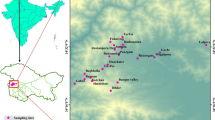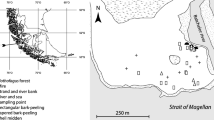Abstract
Our research on Caiçara ethnoecology in the Juatinga Ecological Reserve, in Paraty, Rio de Janeiro State, Brazil, focuses on basket, canoe, and paddle making to understand Caiçara knowledge and stewardship of the landscape. Caiçara differentiate individual plants within a given species to select suitable specimens for a specific cultural product. Choices are based on a combination of attributes such as length of roots, quality of fibers, and tree size and health. Resources are found in multiple ecotopes within a diversity of forest types; not all ecotopes produce suitable individuals for particular cultural products. Hence, people need access to areas of Juatinga Ecological Reserve beyond their community for their material and cultural needs. Our findings are of international significance in suggesting ways to make conservation and sustainable use compatible, since many resource-dependent communities are losing their resource rights in the face of increasing conservation pressures.


Similar content being viewed by others
References
Adams, C. (2000). As populações caiçaras e o mito do bom selvagem: a necessidade de uma nova abordagem interdisciplinar. Revista de Antropologia 43(1): 145–182.
Begossi, A. (1998). Resilience and neo-traditional populations: The caiçaras (Atlantic Forest) and caboclos (Amazon, Brazil). In Berkes, F., and Folke, C. (eds.), Linking social-ecological systems: Management practices and social mechanisms, Cambridge University Press, Cambridge, pp. 129–157.
Berkes, F. (2018). Sacred ecology. Fourth edition, Routledge, New York.
Bockstael, E., Bahia, N. C. F., Seixas, C. S., and Berkes, F. (2016). Participation in protected area management planning in coastal Brazil. Environmental Science & Policy 60: 1–10.
Bockstael, E., and Berkes, F. (2017). Using the capability approach to analyze contemporary environmental governance challenges in coastal Brazil. International Journal of the Commons 11: 799–822.
Boillat, S., Serrano, E., Rist, S., and Berkes, F. (2013). The importance of place names in the search for ecosystem-like concepts in indigenous societies: An example from the Bolivian Andes. Environmental Management 51(3): 663–678.
Borges, R., and Peixoto, L. A. (2009). Conhecimento e uso de plantas em uma comunidade caiçara do litoral sul do estado do Rio de Janeiro, Brasil. Acta Botanica Brasilica 23(3): 769–779.
Brito, M. R., and Senna-Vale, L. (2012). Diversity of plant knowledge in a “Caiçara” community from the Brazilian Atlantic Forest coast. Acta Botanica Brasilica 26(4): 735–747.
Callado, C. H., and Guimarães, R. C. (2010). Estudo dos anéis de crescimento de Schizolobium parahyba (Leguminosae: Caesalpinioideae) após episódio de mortalidade em Ilha Grande, Rio de Janeiro. Revista Brasileira de Botanica 33(1): 85–91.
Carlson, J. A. (2010). Avoiding traps in member checking. The Qualitative Report 15(5): 1102–1113.
Chao, S. (2012). Forest peoples: Numbers across the world. Moreton-in-marsh, Forest Peoples Programme, UK.
Cuerrier, A., Turner, N. J., Gomes, T. C., Garibaldi, A., and Downing, A. (2015). Cultural keystone places: Conservation and restoration in cultural landscapes. Journal of Ethnobiology 35(3): 427–448.
Davidson-Hunt, I. J., and Berkes, F. (2010). Journeying and remembering. Anishinaabe landscape ethnoecology from northwestern Ontario. In Johnson, L. M., and Hunn, E. S. (eds.), Landscape ethnoecology. Concepts of biotic and physical space, Berghahn, New York, pp. 222–240.
Flora do Brasil (2020). Jardim Botânico do Rio de Janeiro. Available at: http://floradobrasil.jbrj.gov.br/. Accessed on: July 19, 2018.
Giraldi, M., and Hanazaki, N. (2014). Use of cultivated and harvested edible plants by Caiçaras—What can ethnobotany add to food security discussions? Human Ecology Review 20(2): 51–73.
Hanazaki, N., Tamashiro, J. Y., Leitao-Filho, H. F., and Begossi, A. (2000). Diversity of plant uses in two Caiçara communities from the Atlantic Forest coast, Brazil. Biodiversity and Conservation 9(5): 597–615.
Hanazaki, N., Oliveira, F. C., Miranda, T. M., and Peroni, N. (2008). Ethnobotany of artisanal fishers. In current trends in human ecology. Cambridge Scholars Publishing, pp. 98–121.
Hunn, E. S. (2007). Etnobiology in four phases. Journal of Ethnobiology 27: 1–10.
Hunn, E. S., and Meilleur, B. A. (2010). Toward a theory of landscape ethnoecological classification. In Johnson, L. M., and Hunn, E. S. (eds.), Landscape ethnoecology. Concepts of biotic and physical space. First edition, Berghahn Books, New York, pp. 5–26.
Lorenzi, H. (2002). Árvores brasileiras: manual de identificação e cultivo de plantas arbóreas nativas do Brasil, v.1, Instituto Plantarum, Nova Odessa.
Idrobo, C. J., Davidson-Hunt, I. J., and Seixas, C. S. (2016). Produced natures through the lens of biodiversity conservation and tourism: The Ponta Negra Caiçara in the Atlantic Forest coast of Brazil. Local Environment 21(9): 1132–1150.
Ingold, T. (2000). The perception of the environment: Essays on livelihood, dwelling and skill. First edition. Routledge, USA and Canada.
Johnson, L. M. (2000). “A place that’s good”, Gitksan landscape perception and ethnoecology. Human Ecology 28(2): 301–325.
Johnson, L. M., and Hunn, E. S. (2010). Landscape ethnoecology. In Johnson, L. M., and Hunn, E. S. (eds.), Landscape ethnoecology. Concepts of biotic and physical space. First edition, Berghahn Books, New York, pp. 1–11.
Kovach, M. (2009). Indigenous methodologies: Characteristics, conversations and contexts, University of Toronto Press Incorporated.
Maldonado, W. (2004). A construção material e simbólica da canoa caiçara em Ilhabela. In Diegues, A. C. (ed.), Enciclopédia Caiçara vol 1, HUCITEC, NUPAUB/CEC, São Paulo, pp. 297–320.
Manão, C.Y.G. (2011). Composição florística e estrutura da comunidade arbustivo-arbórea de um trecho de floresta submontana na vertente sudeste do Parque Estadual da Ilha Grande, Angra dos Reis / RJ. Msc thesis, Universidade do Estado do Rio de Janeiro, Brazil.
Mussolini, G. (1980). Ensaios de antropologia indígena e caiçara, Paz e Terra, Rio de Janeiro.
Poderoso, R. A., Peroni, N., and Hanazaki, N. (2017). Gender influences in the perception and use of the landscape in a rural community of German immigrant descendants in Brazil. Journal of Ethnobiology 37(4): 779–797.
Ribeiro, M. C., Metzger, J. P., Martensen, A. C., Ponzoni, F. J., and Hirota, M. M. (2009). The Brazilian Atlantic Forest: How much is left, and how is the remaining forest distributed? Implications for conservation. Biological Conservation 142(6): 1141–1153.
Sauer, C. (1963). The morphology of landscape. In J. Leighly (ed.), Land and life: A selection from the writings of Carl Ortwin Sauer. University of California Press, Berkeley. pp. 315–350.
Silva, L. F. G. da (2007). Taxonomia de Tachigali Aublet (Leguminosae Caesalpinioideae) na Mata Atlântica. Msc Thesis. Instituto de Pesquisas Jardim Botânico do Rio de Janeiro, Brazil.
Stanley, D. (2003). What do we know about social cohesion: The research perspective of the Federal Government’s social cohesion research network. Canadian Journal of Sociology 28(1): 5–17.
Sylvester, O., and Segura, A. G. (2016). Landscape ethnoecology of forest food harvesting in the Talamanca Bribri indigenous territory, Costa Rica. Journal of Ethnobiology 36(1): 215–233.
Trusler, S., and Johnson, L. M. (2008). “Berry patch” as a kind of place - the ethnoecology of black huckleberry in northwestern Canada. Human Ecology 36(4): 553–568.
Turner, N. J., and Berkes, F. (2006). Coming to understanding: Developing conservation through incremental learning in the Pacific northwest. Human Ecology 34: 495–513.
Turner, N. J., Ari, Y., Berkes, F., Davidson-Hunt, I., Ertug, Z. F., and Miller, A. M. (2009). Cultural management of living trees: An international perspective. Journal of Ethnobiology 29: 237–270.
Vianna, L. P. (2008). De invisíveis a protagonistas: populações tradicionais e unidades de conservação. First edition, FAPESP, São Paulo.
Acknowledgments
We would like to thank the research participants from the Juatinga Ecological Reserve. We thank the funding agencies below. Dr. Pedro Fiaschi and Graziela Dias Blanco assisted with plant identification. Specimens were deposited in the Herbarium FLOR at the Federal University of Santa Catarina and the Herbarium EAFM of the Federal Institute of Science and Technology of Amazonas in Manaus.
Funding
This study was financed in part by the Coordenação de Aperfeiçoamento de Pessoal de Nível Superior - Brasil (CAPES) - Finance Code 001 (doctoral research award to DP), Organization of American States (OAS) for funding for fieldwork, CNPq (productivity grant for NH 309613/2015-9), the IDRC/CRC International Research Chairs Initiative (A. Begossi / F. Berkes), and the Canada Research Chairs Program (http://www.chairs.gc.ca).
Author information
Authors and Affiliations
Corresponding author
Ethics declarations
This project was approved by the Research Ethics Board of the University of Manitoba (JFREB J2012:155) and INEA (Research Permit INEA 051/2015). The ethics code protocols of the International Society for Ethnobiology were followed throughout the research process. Informed consent was obtained from research participants prior to data collection.
Conflict of Interest
The authors declare that they have no conflict of interest.
Additional information
Publisher’s Note
Springer Nature remains neutral with regard to jurisdictional claims in published maps and institutional affiliations.
Electronic Supplementary Material
ESM 1
(DOCX 20 kb)
Rights and permissions
About this article
Cite this article
Peterson, D., Berkes, F., Davidson-Hunt, I. et al. The Caiçara in Juatinga Ecological Reserve, Brazil: Landscape Ethnoecology of Cultural Products. Hum Ecol 47, 827–838 (2019). https://doi.org/10.1007/s10745-019-00126-3
Published:
Issue Date:
DOI: https://doi.org/10.1007/s10745-019-00126-3




